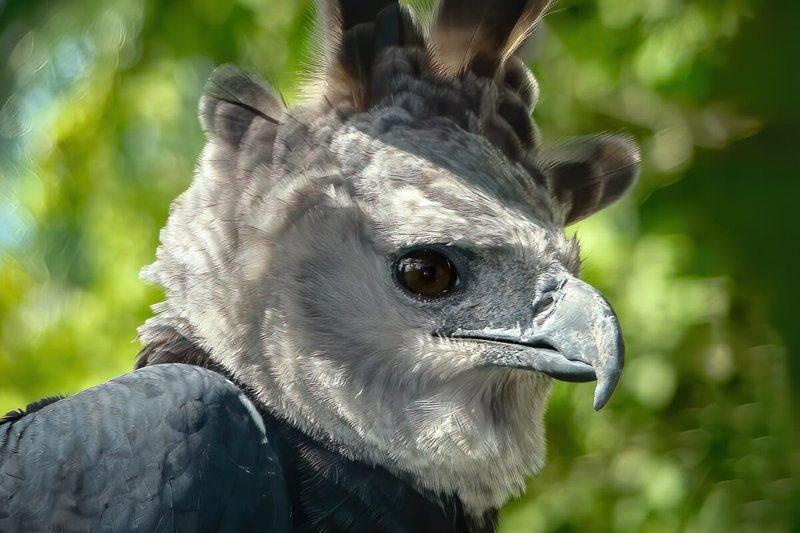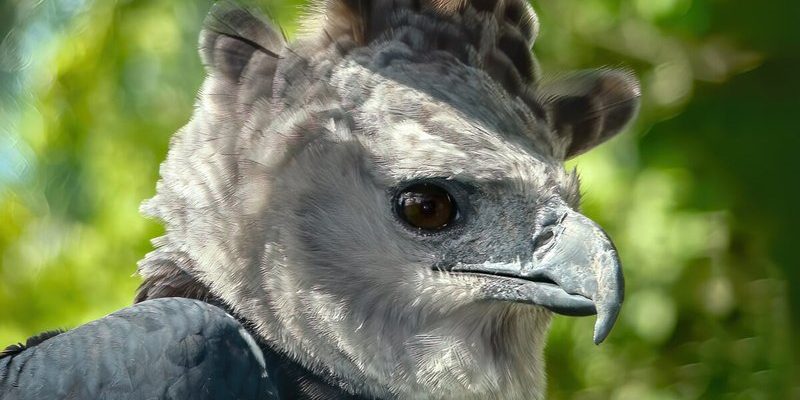
The harpy eagle is often found in the lush canopies of tropical rainforests, particularly in Central and South America. They are no ordinary birds; they’re powerful hunters who can take down prey as large as monkeys and sloths. So, if you’re keen on birdwatching or just curious about nature, knowing how to identify a harpy eagle will enrich your experiences. Let’s break down some key tips and traits to help you spot one in the wild.
Understanding the Harpy Eagle’s Appearance
One of the first things you’ll notice when you see a harpy eagle is its stunning size. These birds are among the largest eagles in the world, with a wingspan that can reach up to 7 feet. Their body is robust, giving them a powerful look that’s hard to miss. Think of them like the linebackers of the bird kingdom—strong and impressive.
In terms of coloration, harpy eagles possess a striking look with a dark gray to black plumage on their back and wings, while their underparts are lighter and streaked. Their distinctive white head and facial markings give them a unique charm, almost like they’re wearing a crown. Observing the contrast in their feathers can be a giveaway because it sets them apart from other eagles.
A key aspect to look for is their legs—yes, their legs! Harpy eagles have exceptionally thick legs equipped with powerful talons. These talons can measure over 5 inches long, perfect for grasping onto prey. If you spot a bird with large, muscular legs perched high in the trees, there’s a good chance it’s a harpy eagle.
Habitat and Range: Where to Look
You might be wondering, “Where the heck do I even go to find a harpy eagle?” Well, they primarily thrive in tropical rainforests, but they can also inhabit subtropical forests, and even some cloud forests. Countries like Brazil, Colombia, and Peru are among the best spots to see these magnificent birds.
When searching for the harpy eagle, think of places with dense canopy cover. They tend to stay high up in the trees, so having binoculars can be a game-changer. Look for tall trees with big branches, and that’s where these eagles like to perch. Honestly, the more remote the area, the better your chances; they prefer undisturbed habitats.
Timing can also play a role. Early mornings or late afternoons are often the best times to catch these birds in action. During these hours, they’re typically more active and may soar down from their nests to hunt for food. So, grab your gear and set out early to increase your chances of spotting a harpy eagle!
Behavioral Traits to Observe
Beyond their physical traits, observing a harpy eagle’s behavior can help you identify them. One of their notable behaviors is their hunting technique. These eagles are known for their impressive flights, which look almost effortless as they glide silently through the trees. They tend to prefer a slow, methodical approach when hunting, so if you see a large bird moving slowly and deliberately, pay close attention.
Another behavior to note is their distinctive call. They have a loud, deep vocalization that can be heard within the forest. Their calls are quite distinct and can sound like a series of barks or a hoarse scream. If you hear something that makes you stop in your tracks, it could be the harpy eagle announcing its presence.
Pair bonding is also significant among harpy eagles. They are monogamous and often seen together, especially during nesting season. If you spot one eagle, keep watching; there might be a mate nearby! Watching them interact can be a rewarding experience, giving you a glimpse into their lives.
Spotting Techniques for Birdwatchers
Birdwatching can feel a little like a game of hide-and-seek, especially with elusive creatures like the harpy eagle. To up your spotting game, consider using some effective techniques. First, invest in a good pair of binoculars. A solid magnification of 8x to 10x works well without making things too shaky.
It’s also helpful to learn to recognize their silhouettes against the sky. Their broad wings and distinctive head shape can be identified even from a distance. When they fly, they often glide gracefully, using thermal currents to maintain their altitude.
Don’t forget to be patient. Find a quiet spot, and hang out there for a while. Sometimes, the best sightings happen when you least expect them. Keep your eyes peeled for movement in the trees or any sudden sounds—those might be signs of a harpy eagle nearby.
Conservation Status of the Harpy Eagle
Understanding the conservation status of the harpy eagle is crucial to appreciating their role in the environment. Unfortunately, habitat loss due to deforestation poses a significant threat to their survival. These eagles rely on large areas of undisturbed forest, so as these habitats shrink, so do their chances of survival.
Organizations and local governments are working hard to protect the habitats of harpy eagles, creating reserves that support their populations. If you’re passionate about wildlife, consider supporting efforts aimed at conserving rainforests and the species that inhabit them. Every little bit helps.
By being aware of their status, we can also become advocates for these incredible birds. Responsible birdwatching practices, like keeping a respectful distance and not disturbing their nests, can make a world of difference. Remember, when we protect their home, we’re ensuring that future generations can also experience the awe of seeing a harpy eagle in the wild.
Final Thoughts: The Joy of Birdwatching
Birdwatching is more than just spotting birds; it’s about connecting with nature and appreciating the incredible diversity of life that exists around us. Identifying a harpy eagle in the wild can be an unforgettable experience, akin to discovering a hidden treasure. With their striking appearance, fascinating behaviors, and critical role in the ecosystem, these birds inspire awe and wonder.
So, grab your binoculars, hit the trails, and keep your eyes peeled for the harpy eagle. Remember to immerse yourself in the experience, cherish the moments, and respect the wildlife around you. Happy birdwatching!

